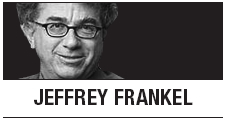CAMBRIDGE ― The United States is famous for its ability to innovate. Aspiring fiscal conservatives around the world thus might be interested in learning four tricks that American politicians commonly use when promising to cut taxes while simultaneously reducing budget deficits.
These are hard promises to keep, for the simple reason that a budget deficit equals government spending minus tax revenue. But, each of the four tricks

has been refined over three decades. Indeed, they first acquired their colorful names in the early years of Ronald Reagan’s presidency: the “magic asterisk,” the “rosy scenario,” the Laffer hypothesis, and the “starve the beast” scenario. As shop-worn as these tricks are, voters and journalists still fall for them, so they remain useful tools for anyone posing as a fiscal conservative.
The first term was coined by Reagan’s budget director, David Stockman. Originally, it was an act of desperation, because the numbers in the 1981 budget plan did not add up. “We invented the ‘magic asterisk,’” Stockman wrote in “The Triumph of Politics in 1986.” “If we couldn’t find the savings in time ― and we couldn’t ― we would issue an IOU. We would call it ‘Future savings to be identified.’”
Ever since, the magic asterisk has become a familiar American device. Recent examples include the recommendation of the Simpson-Bowles commission ― tasked in 2010 with charting a fiscal-consolidation path ― to cut real spending growth by precise amounts, without saying where the cuts would be made. U.S. presidential candidate Mitt Romney’s spending plans contain the same conjuring trick. So, too, his plan to eliminate enough tax expenditures to offset the $5 trillion in revenue lost from cutting marginal tax rates by 20 percent, while refusing to say which tax loopholes he would close.
As Election Day nears, the pressure on a candidate to be more specific grows. The conjurer thus resorts to the rosy scenario: since he cannot find enough tax loopholes to eliminate, he must claim that what he meant by closing the revenue gap was that stronger economic growth will bring in the additional revenue.
Here, Murray Weidenbaum, the chairman of Reagan’s first Council of Economic Advisers, deserves the credit for inventing what he called “perhaps my most lasting legacy.” In its early years, the Reagan administration forecast 5 percent income growth (twice the long-run average), in order to imply in its projections a boost to revenues big enough to make up for its many tax cuts. Since then, candidates of both major U.S. political parties have relied on rosy scenarios.
Indeed, overly buoyant, official growth forecasts are a fact of life in almost all of a sample of 33 countries, contributing to overly optimistic budget forecasts. European governments are particularly biased. From 1991 to 2010, for example, Italy forecast growth rates at the three-year horizon that were, on average, 2.3 percentage points above what was actually achieved.
In the Republican primaries last year, candidate Tim Pawlenty assumed a 5 percent growth rate to make his own plan work. He was all but laughed out of the race. Romney probably cannot get away with this sleight-of-hand, either. The press asks, “Why should we believe that the growth rate will magically accelerate just because you become president? Where will this GDP come from? It sounds like pulling a rabbit out of a hat.”
Right on cue, it is time for the famous Laffer hypothesis ― the proposition, identified with the economist Arthur Laffer and “supply-side economics,” that reductions in tax rates are like magic beans: they so stimulate economic growth that total tax revenue (the tax rate times income) goes up rather than down.
One might think that the Romney campaign would not resurrect so discredited a trick. After all, two of his main economic advisers, Glenn Hubbard and Greg Mankiw, have both authored textbooks in which they argue that the Laffer hypothesis is incorrect as a description of U.S. tax rates. Mankiw’s book, in its first edition, even called proponents of the hypothesis “charlatans.”
Each Republican presidential candidate since Reagan has had good economic advisers who disavow the Laffer hypothesis. Yet, time and again, the president (or candidate), his vice president (or running mate), and his political aides eventually rely on Laffer’s flawed argument. And they, not academic economists, formulate policy. Hubbard and Mankiw advised former President George W. Bush in his first term, when he cut taxes and transformed a record surplus into a record deficit.
The final trick, “starve the beast,” typically comes later, if and when the president has enacted his tax cuts and discovers that smoke and mirrors do not trump reality. He cannot find enough spending to cut (the magic asterisk has disappeared up the conjurer’s sleeve); the acceleration in GDP is nowhere to be seen (the rosy scenario having vanished); and tax revenues have not grown (no rabbit in the Laffer hat).
The audience is now told that losing tax revenue and widening the budget deficit was the plan all along. The performer explains that the deficit is all the fault of congress for not cutting spending and that the only way to tame the beast is to raise the budget deficit because “Congress can’t spend money it doesn’t have.” This trick never works either, of course. Congress can, in fact, spend money it doesn’t have, especially if the president has been quietly sending it budgets that call for just that.
By the time the crowd realizes that it has been conned, the magician has already pulled off the greatest trick of all: yet another audience that came to see the deficit shrink leaves the theater with the deficit bigger than before.
By Jeffrey Frankel
Jeffrey Frankel is professor of capital formation and growth at Harvard University. ― Ed.
(Project Syndicate)








